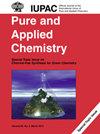Speciation and mobility of uranium isotopes in the Shu River: impacts for river to sea transfer
IF 2
4区 化学
Q3 CHEMISTRY, MULTIDISCIPLINARY
引用次数: 0
Abstract
Fresh water outflows to sea are a source of marine contamination by radionuclides, most originating from nuclear industry operations. Usually, these lead to small amounts of radionuclides entering the sea, for example, because of the discharge of cooling water. However, under accident conditions large amounts of radionuclides may enter river systems. The extent of radionuclide transport along freshwater systems and their subsequent dispersal in the ocean depends upon their speciation. This manuscript examines the speciation of uranium, with particular reference to sulphate complexes, along the Shu River in Central Asia with a view to predict its transport along such rivers to receiving seas. The speciation of uranium isotopes in the Shu River (at the border of Kazakhstan and Kyrgyzstan) was determined. Calculations were based on the measured concentrations of Ca舒河中铀同位素的种类和流动性:对河流向海洋转移的影响
淡水外流入海是放射性核素污染海洋的一个来源,大部分源于核工业作业。通常,由于冷却水的排放等原因,会导致少量放射性核素进入海洋。然而,在事故条件下,大量放射性核素可能会进入河流系统。放射性核素沿淡水水系迁移的程度及其随后在海洋中的扩散取决于它们的形态。本手稿研究了中亚蜀河沿岸铀的分型,特别是硫酸盐复合物,以预测铀沿此类河流向受纳海洋的迁移。本文测定了蜀河(哈萨克斯坦和吉尔吉斯斯坦交界处)中铀同位素的种类。计算基于 Ca2+、Mg2+、Na++K+、HCO3-、Cl-、SO4 2- 和铀同位素的测量浓度。这些计算是通过滴定法、重量法或铀同位素的阿尔法粒子光谱法确定的。几乎所有铀都以三种可溶性络合物之一的形式存在,即 [UO2OH]+、[UO2(CO3)2(H2O)2]2- 或 [UO2(CO3)3]4-。然而,尽管水中的硫酸根离子浓度很高,尤其是在哈萨克斯坦的下舒地区,但铀以硫酸根络合物的形式存在于分析水中的可能性非常低。可溶性离子的存在与它们在淡水系统中的流动性及其向海洋环境的转移是一致的。没有证据表明硫酸盐的流入会产生影响。
本文章由计算机程序翻译,如有差异,请以英文原文为准。
求助全文
约1分钟内获得全文
求助全文
来源期刊

Pure and Applied Chemistry
化学-化学综合
CiteScore
4.00
自引率
0.00%
发文量
60
审稿时长
3-8 weeks
期刊介绍:
Pure and Applied Chemistry is the official monthly Journal of IUPAC, with responsibility for publishing works arising from those international scientific events and projects that are sponsored and undertaken by the Union. The policy is to publish highly topical and credible works at the forefront of all aspects of pure and applied chemistry, and the attendant goal is to promote widespread acceptance of the Journal as an authoritative and indispensable holding in academic and institutional libraries.
 求助内容:
求助内容: 应助结果提醒方式:
应助结果提醒方式:


